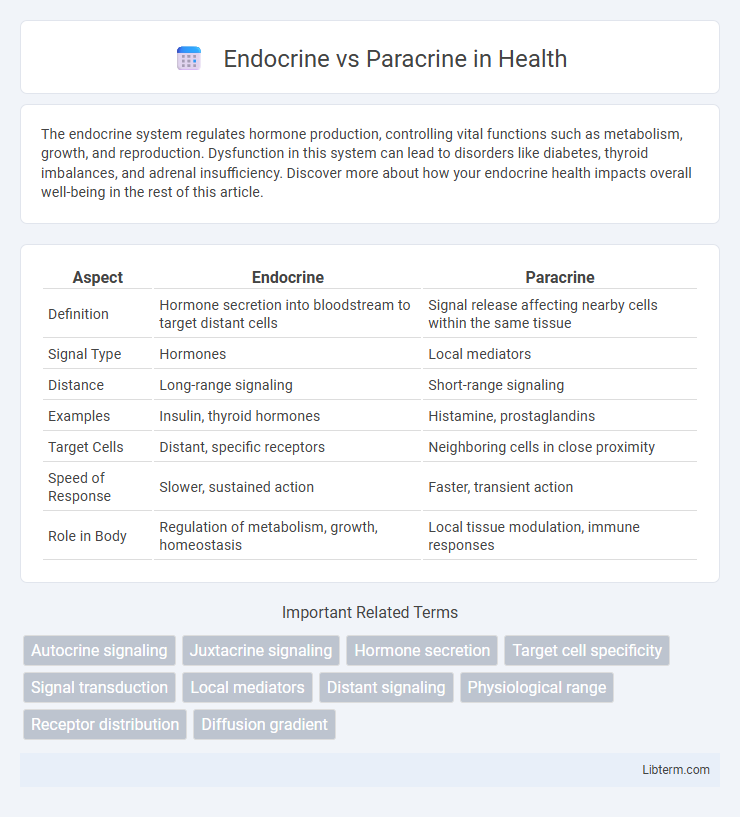The endocrine system regulates hormone production, controlling vital functions such as metabolism, growth, and reproduction. Dysfunction in this system can lead to disorders like diabetes, thyroid imbalances, and adrenal insufficiency. Discover more about how your endocrine health impacts overall well-being in the rest of this article.
Table of Comparison
| Aspect | Endocrine | Paracrine |
|---|---|---|
| Definition | Hormone secretion into bloodstream to target distant cells | Signal release affecting nearby cells within the same tissue |
| Signal Type | Hormones | Local mediators |
| Distance | Long-range signaling | Short-range signaling |
| Examples | Insulin, thyroid hormones | Histamine, prostaglandins |
| Target Cells | Distant, specific receptors | Neighboring cells in close proximity |
| Speed of Response | Slower, sustained action | Faster, transient action |
| Role in Body | Regulation of metabolism, growth, homeostasis | Local tissue modulation, immune responses |
Introduction to Endocrine and Paracrine Signaling
Endocrine signaling involves the release of hormones into the bloodstream, allowing distant target cells to respond, while paracrine signaling operates locally by secreting signaling molecules that affect neighboring cells within the same tissue. Key endocrine glands such as the pituitary, thyroid, and adrenal glands regulate vital physiological processes through hormone secretion, whereas paracrine signals, including growth factors and cytokines, mediate immediate cellular responses in the local environment. Understanding the mechanisms and spatial range of endocrine versus paracrine signaling is crucial for exploring how cells coordinate complex biological functions and maintain homeostasis.
Defining Endocrine Signaling
Endocrine signaling involves the release of hormones directly into the bloodstream, allowing signals to reach distant target cells throughout the body. Unlike paracrine signaling, which affects nearby cells through local diffusion, endocrine hormones travel systemically to regulate various physiological processes. Key endocrine glands such as the pituitary, thyroid, and adrenal glands produce hormones like insulin, cortisol, and thyroid hormone that coordinate growth, metabolism, and homeostasis.
Understanding Paracrine Communication
Paracrine communication involves local signaling where cells release chemical messengers that affect neighboring target cells within the same tissue, contrasting with endocrine signaling that releases hormones into the bloodstream for distant action. This localized mechanism allows for precise regulation of cellular activities such as growth, immune responses, and tissue repair. Understanding paracrine signaling pathways, including growth factors, cytokines, and neurotransmitters, is crucial for insights into developmental biology and disease processes like cancer and inflammation.
Key Differences Between Endocrine and Paracrine Systems
Endocrine systems release hormones directly into the bloodstream, affecting distant target cells and enabling widespread physiological regulation, while paracrine systems secrete signaling molecules that act locally on nearby cells within the same tissue. Endocrine signaling involves glands like the pituitary or thyroid, producing long-lasting, systemic effects, whereas paracrine signaling is typically rapid and limited to the immediate cellular environment, such as growth factors in tissue repair. The key difference lies in signal range and mode of delivery: endocrine's systemic circulation versus paracrine's localized diffusion.
Hormones in Endocrine Signaling
Hormones in endocrine signaling are secreted directly into the bloodstream, enabling them to travel long distances and regulate physiological processes in target organs throughout the body. This long-range communication contrasts with paracrine signaling, where signaling molecules affect only nearby cells within the immediate tissue environment. Key endocrine hormones include insulin, cortisol, and thyroid hormones, which play essential roles in metabolism, stress response, and growth regulation.
Local Mediators in Paracrine Actions
Local mediators in paracrine signaling include cytokines, growth factors, and nitric oxide, which act on nearby target cells within the same tissue environment. Unlike endocrine signals that travel through the bloodstream to distant organs, paracrine factors exert their effects rapidly and transiently by diffusion over short distances. These mediators play critical roles in tissue repair, immune responses, and cellular communication by modulating cell behavior in a localized manner.
Examples of Endocrine vs Paracrine Mechanisms
Endocrine signaling involves hormones such as insulin, secreted by the pancreas and traveling through the bloodstream to regulate glucose levels in distant tissues like muscle and liver. Paracrine signaling includes neurotransmitters like nitric oxide, which diffuses locally to affect neighboring smooth muscle cells and induce vasodilation. Another example of endocrine action is thyroid hormones influencing metabolism body-wide, while paracrine factors like growth factors modulate cellular functions within specific tissue microenvironments.
Roles in Homeostasis and Cellular Regulation
Endocrine signaling involves hormones released into the bloodstream to regulate distant target cells, playing a critical role in maintaining systemic homeostasis such as blood glucose levels and metabolism. Paracrine signaling functions through local mediator molecules that act on neighboring cells, enabling rapid cellular regulation in tissue repair and immune responses. Both mechanisms are essential for coordinating physiological balance, with endocrine pathways ensuring long-range communication and paracrine signals facilitating precise local cellular control.
Clinical Implications of Endocrine and Paracrine Disorders
Endocrine disorders such as diabetes mellitus and thyroid dysfunction result from hormone imbalances affecting distant target organs, leading to systemic symptoms and requiring hormone replacement or modulation therapies. Paracrine disorders, including localized inflammatory diseases and certain cancers, arise from abnormal signaling between adjacent cells, necessitating targeted treatments to interrupt pathological cellular communication. Understanding the distinct signaling pathways in endocrine versus paracrine mechanisms is critical for developing precise diagnostic tools and personalized treatment strategies.
Future Directions in Hormonal Signaling Research
Future directions in hormonal signaling research emphasize the integration of advanced omics technologies to map endocrine and paracrine pathways at single-cell resolution. Emerging techniques such as spatial transcriptomics and live-cell imaging are anticipated to unravel the complex intercellular communication and temporal dynamics distinguishing systemic endocrine signaling from localized paracrine effects. These innovations promise novel therapeutic targets for diseases involving hormonal dysregulation by precisely modulating either endocrine hormone release or paracrine cellular interactions.
Endocrine Infographic

 libterm.com
libterm.com